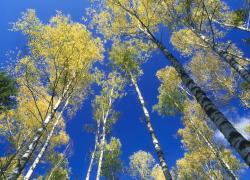 Asset Publisher
Asset Publisher
The State Forests National Forest Holding
The State Forests National Forest Holding is the largest organisation in the European Union managing forests, which belong to the State Treasury and celebrating its 90 anniversary this year.
Presently, we manage the area of one third of Poland's territory. Not long after the end of the Second World War, there was only 21 % of the area. Every year we plant 500 million of new trees, as we want Polish forests grow all the time.
Every year Polish foresters plant 500 million of trees.
85 % of nature reserves in Poland are located within the State Forests. 40 % of the forests managed by General Directorate of the State Forests are protected within the framework of European network Natura 2000. We fight against many threats: natural disasters, plaques of insects, trees' diseases, fires, pollutions, as well as poaching and vandalism.
We take care the forestry supplying the market with timber, as ecological and universal material, to be carried on in accordance with rules of balanced development (photography P.Fabjański).
One of our major tasks is making forests accessible to the society. We invite you to take advantage of these beautifully located within the forest wilderness holiday resorts, forester's lodges or guest rooms. That is for you, we create thousand kilometres of hiking trails, cycling paths or camping sites. All the above mentioned, you can find in service www.czaswlas.pl.
We also take care the forestry supplying the market with timber, as ecological and universal material, to be carried on in accordance with rules of balanced development. We obtain over 30 million of cubic meters of wood annually, twice as much as at the beginning of the nineties of the XX century.
Despite of this, the average of wood abundance per hectare of our forests is one fourth bigger than 20 years ago and 40% bigger than the average of European Union currently amounts.
In Poland in sectors connected with the forestry, there work about 375 thousand of people. It means that each 40 working Pole works in the forest.
In Poland in sectors connected with the forestry, there work about 375 thousand of people. It means that each 40 working Pole works in the forest. The sector of wood processing works out approximately 8 % of our GDP (Gross Domestic Product). Among others, thanks to the timber from the State Forests Poland is the 10 largest producer of furniture in the world, and the 4 largest furniture exporter.
The State Forests employ 25 thousand people. That way we are the 9 biggest employer in Poland. Among the largest companies in our country it takes 22 place in respect of its incomes and 11 place in respect of its profits. The value of assets, we manage, reaches 300 million zl. If we add social values, it will be worth one billion zlotych. We do not use money from the budget, but we earn money on our own to support the business. In spite of the financial crisis, since 2002, we continuously note down profits. Moreover, we pay taxes amounting 1,3 billion zl annually.
87 % of Poles think, the foresters are competent. We willingly share our knowledge of Polish forests, of their history and of nature values with the others. We publish books, periodicals, brochures; we also administer the website www.lasy.gov.pl . For children, the youth and teachers, we prepared internet service "E-lynx' Lynx Forest" (www.erys.pl). Our staff has supported schools in field of nature education for years. We also organise many actions to let people broaden their knowledge about forest, nature and ecology.
 Asset Publisher
Asset Publisher
Szyszkobranie w Nadleśnictwie Syców
Szyszkobranie w Nadleśnictwie Syców
Z wyselekcjonowanych drzew sosny rychtalskiej udało się zebrać ponad 6 ton szyszek.
Zima to szczególny okres dla działu hodowli lasu. To właśnie w tym okresie roku dojrzewają nasiona sosen. Jeśli powierzchnia leśna ma się odnowić w sposób naturalny, leśnicy czekają na pierwsze ciepłe, słoneczne dni wiosny. Wtedy łuski szyszek podnoszą się wypuszczając na wiatr maleńkie nasiona. Jeśli jednak leśniczy zdecyduje o tym aby zamiast siewu wykorzystać sadzenie młodych drzewek, będzie ich potrzebował w liczbie kilku tysięcy sztuk na jeden hektar. Produkcja sadzonek, które zostaną wykorzystane za rok czy dwa, rozpoczyna się już teraz.

Nasiona używane do produkcji sadzonek pochodzą z wyselekcjonowanych drzewostanów oraz plantacji nasiennych. Na terenie Nadleśnictwa Syców występuje wyjątkowy ekotyp sosny zwyczajnej. Mowa tu o sośnie rychtalskiej, która słynie z tego, że bardzo łatwo adaptuje się w różnych warunkach. Stąd na terenie Nadleśnictwa Syców znajduje się imponująca ilość drzew matecznych sosny – 51 szt. a także blisko 400 hektarów drzewostanów i plantacji nasiennych tego gatunku.
W tym roku zbieraliśmy szyszki w wyłączonych drzewostanach nasiennych (WDN). Są to powierzchnie leśne, wyłączone z użytkowania rębnego i przeznaczone do intensywnej produkcji nasion. Aby nie uszkodzić drzew, zbioru dokonaliśmy za pomocą specjalnego wysięgnika, dzięki któremu zbieracze, mogli wznieść się 30 metrów ponad ziemię. Zbioru dokonano również na plantacjach nasiennych, gdzie drzewa są dużo niższe i istnieje możliwość zrywania szyszek z drabiny lub specjalnej platformy.

W ten sposób udało się zebrać 6,5 tony szyszek, które poddane specjalnemu zabiegowi wyłuszczania wydadzą ok. 100 kg nasion. Z takiej ilości można wyhodować ok. 5 000 000 sadzonek i posadzić ok. 500 hektarów lasu!


 fot. Paweł Fabijański
fot. Paweł Fabijański
 fot. Paweł Fabijański
fot. Paweł Fabijański
 fot. Paweł Fabijański
fot. Paweł Fabijański

